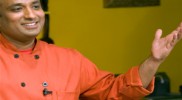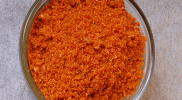This simple apple cinnamon boiled food recipe is great for breakfast. This is a easy to m...
Burned brinjal pachi pulusu is a classic Andhra dish prepared with tamarind juice, burned...

Tutti Frutti cookies are amazing tea time snack - shortcrust cookies mixed with tutti fru...

Thotakura pulusu (stew) is a very simple and tasty dish spiced up with chillies and sweet...

Teeka Chutney is made with a nice mix of roasted peanuts, sesame seeds, coconut powder, c...
A Telangana snack made to celebrate the harvest festival of Sankranthi. ...
Rava dosa is a very tasty and crispy semolina pan cakes.It is a perfect breakfast that can be prepared and served instantly with any chutney.
Rava dosa (quicky version) or Instant Rava dosa is a very tas... Read More..
About Recipe
Rawa Dosa recipe, Semolina dosai, Sooji attu |
|||||||||||||||||||||||||||||||||||||
|
|||||||||||||||||||||||||||||||||||||
Rava dosa (quicky version) or Instant Rava dosa is a very tasty and crispy semolina crepe/ pancakes and a perfect for a quick in easy breakfast. Rava dosa is a favorite recipe in many homes and there are different versions in the measurements of rice flour, sooji (semolina) and maida (all purpose flour). The rava dosa is a quick and easy to cook dish which is made delicious and tastes best with sambar and chutney. Unlike the ordinary dosa, this recipe does not need to be fermented. For making ordinary dosa, we need to the leave the batter for about 6-7 hours to ferment (or overnight ferment).
For Rava Dosa, the ingredients need to be soaked for just 30 mins to 1 hour. This is apt for the jiffy tiffin making. Rava dosa is a combination of rice flour, maida and suji and water to get the right consistency, allow standing for 30 mins. Temper the batter with cumin seeds, green chillies, curry leaves, grated carrot and salt. Pour the dosa onto the hot griddle to get crisp and delicious dosas. Remove and serve hot with Tomato Chutney, Peanut chutney, Ginger chutney or with Peanut powder and Sambar. A basic dosa is a fermented crepe or pancake made from rice flour and black lentils. It is a typical dish in South Indian cuisine, eaten for breakfast or dinner, and is rich in carbohydrates and protein.
It is a day to day diet for people in present day Tamil Nadu, Andhra Pradesh, Karnataka and to some extent in Kerala also. Dosa is also popularly known as dhosha, dosay, dosai, dhosai, tosai, thosai, or dvashi in various regions as per their language. In different countries it is spelled in different manners, for example, in Malaysia and Singapore it is spelled thosai, because of the different way in which Tamil is transliterated in South-East Asia. Though dosa typically refers to the version made with rice and lentils there are many other versions of dosa exist and are popular in varying degrees. This is sometimes specific to a region in India.
Other types of dosa include: Pesarattu green moong dosa, ragi dosa, banana dosa, masala dosa and so on. To prepare the rava dosa firstly mix all ingredients (sooji or semolina, all purpose flour – maida, rice flour) add water (or buttermilk) and make thin batter and sprinkle over hot griddle if it is not a non stick pan, spray non-stick spray, wipe clean and sprinkle the batter and apply butter or oil serve hot with pickle, chutney, use potato stuffing - just as used in masala dosa.
Do try this variation of dosa and you will really enjoy the crispness of the dosa.It has a unique taste than the normal dosa and enlightens your taste buds. Do view the making of this dish at:
https://www.vahrehvah.com/rava-dosa-quick-version
It takes practice to prepare rava dosas. Usually many do not get the batter of the rava dosa perfect. To prepare this dish you need to keep few things mind while making dosas. The batter has to be prepared atleast an hour or half before you want to eat. There is no need of fermentation for the rava dosa batter unlike the masala dosa batter. This is an instant preparation.
The batter should of pouring consistency like a thick buttermilk consistency but not very thick. Resting the batter in the fridge for a few hours also helps in making a crisp dosa, not that you cannot prepare crisp dosas with batter sitting for just an hour. The most important factor in the making of this dosa is adjusting the heat control. An iron tawa or griddle requires higher heat as compared to non-stick pan.
There are many variations in preparing rava dosa. You could add grated carrot and coconut to the batter along with rest of ingredients, Or add some sliced onions while the dosa is cooking. Broken cashew nut pieces can also be added to the dosa batter. At the time of preparing dosa, use the ladle to stir the dosa batter well, as all the flours mixture tends to sink to the bottom of the vessel like a thick residue. So combine well each time you pour the dosa batter over the tawa. Use considerable oil as it helps the rava dosa get crisp. (forget of the calories if you want to relish a perfect crisp rava dosa). Do not store the batter for more than 2 to 3 days in the fridge or else it will turn sour.


Bhushan Prasad Posted on Sun Feb 28 2016
Awesome Rava Dosa, easy and quick to prepare?
Reply 0 - Replies

Nitya Shetty (nityas2012) Posted on Wed Mar 02 2016
I tried making rava dosa on an iron tava. The dosa does not come out easily, the bottom of the dosa does not come off the tava and the top remains soft uncooked. Can you advise me why this is so.?
Reply 0 - Replies

Savera Rizwana Posted on Sun Mar 06 2016
bcoz of u...I made this dose so many times ...every time it cums amazing. ..thanks for this wonderful recipe chef ...you are d best. ..?
Reply 0 - Replies
Rizwan Takkhar Posted on Mon Mar 07 2016
You are the most enthusiastic chef in the world. And I love it. LOOK AT THA CULUH?
Reply 0 - Replies
Mukesh Sharma Posted on Thu Mar 10 2016
i enjoy your recipy and your styl of taking very much?
Reply 0 - Replies
Shirley Francis Posted on Fri Mar 11 2016
Awesome Awesome Awesome. I will try making this awesome dosa on Sunday. Thank you ?
Reply 0 - Replies

 Easy recipes
Easy recipes
 Healthy Recipes
Healthy Recipes
 Dessert Recipes
Dessert Recipes
 Mutton and Lamb
Mutton and Lamb  Indian Bread Recipes
Indian Bread Recipes
 Dal Recipes
Dal Recipes
 Chutney and Pickles
Chutney and Pickles  Indo-Chinese Recipes
Indo-Chinese Recipes
 Snacks and Appetizers
Snacks and Appetizers
 Low Fat Recipes
Low Fat Recipes
 Chaat Recipes
Chaat Recipes
 Biryani and Rice
Biryani and Rice  Curry Recipes
Curry Recipes
 Indian Sweet Recipes
Indian Sweet Recipes
 Egg Recipes
Egg Recipes
 Paneer Recipes
Paneer Recipes
 Chicken Recipes
Chicken Recipes
 Indian tiffins
Indian tiffins
 Egg less Recipes
Egg less Recipes
 Soups and Salads
Soups and Salads
 Indian Sea Food
Indian Sea Food
 Manchurian Recipes
Manchurian Recipes
 Indian Drinks Recipes
Indian Drinks Recipes
 Dinner Recipes
Dinner Recipes
Jayanthi Nagarajan Posted on Thu Feb 16 2017
Vah 're vah.fantastic.you really inspire me.you are a wonderful chef n teacher.
Reply 0 - Replies